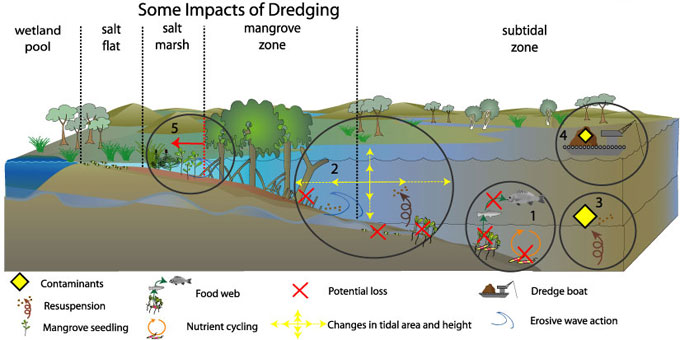
- Dredging results in the short term degradation of animals, vegetation and microbial communities that live in the dredged sediment. This reduces the estuary’s capacity for nutrient cycling, primary production and habitat provision and can have flow on effects up the food web. Though these effects tend to be short lived, in some cases they may trigger long-term changes. (Larkum and West, 1990; Lewis et al, 2001; Thrush and Dayton, 2002; Lohrer and Wertz, 2003; da Silva et al, 2004; Waycott et al, 2004; Ohimain et al; 2005)
- Changes in channel profile caused by dredging can increase tidal area, wave height and water velocity, resulting in bank erosion. Eroding banks threaten mangroves and other mudbank communitites and can lead to increased turbidity. Suspended sediment in the water column blocks light, reducing benthic primary productivity and inhibits the ability of benthic plants to recover from impacts of dredging. (Pringle, 1989; Larkum and West, 1990; Lewis et al, 2001; Rasheed and Balchand; 2001; Lohrer and Wertz, 2003; Sampson et al, 2005)
- Dredging exposes anaerobic layers of sediment, potentially disturbing and remobilising toxic sediments, releasing contaminants. This has implications for water quality. (Linkov et al, 2001; Thibodeaux and Duckworth, 2001; Van Den Berg, 2001; Nayar et al, 2004)
- Dredge spoil needs to be deposited somewhere, though this could be deemed habitat creation, it can smother existing habitats and frequently contains contaminants which often move and bioaccumulate through the food web. The impacts of dredge spoil disposal can range from short term to long term (Linkov et al, 2001; Smith and Rule, 2001; National Ocean Disposal Guidelines for Dredged Material, 2002; Fredette and French, 2004)
- Changes to tidal range and wave action can result in mangrove encroachment into saltmarsh areas (Saintilin and Williams, 1999)
References
- da Silva, J.F., Duck, R.W. & Catarino, J.B. 2004, “Seagrasses and sediment response to changing physical forcing in a coastal lagoon”, Hydrology and Earth System Sciences, vol. 8, no. 2, pp. 151-159.
- Larkum, A.W.D., West, R.J. 1990 Long-term Changes of Seagrass Meadows in Botany Bay, Australia Aquatic Botany, 37 (1): 55-70.
- Lewis, M.A., Weber, D.E., Stanley, R.S. & Moore, J.C. 2001 Dredging impact on an urbanized Florida bayou: effects on benthos and algal-periphyton, Environmental Pollution, vol. 115, no. 2, pp. 161-171.
- Linkov, I., von Stackelberg, K.E., Burmistrov, D. & Bridges, T.S. 2001, Uncertainty and variability in risk from trophic transfer of contaminants in dredged sediments, Science of the Total Environment, vol. 274, no. 1-3, pp. 255-269.
- Lohrer, A.M. & Wetz, J.J. 2003, Dredging-induced nutrient release from sediments to the water column in a southeastern saltmarsh tidal creek, Marine Pollution Bulletin, vol. 46, no. 9, pp. 1156-1163.
- Nayar, S., Goh, B.P.L. & Chou, L.M. 2004, Environmental impact of heavy metals from dredged and resuspended sediments on phytoplankton and bacteria assessed in situ mesocosms, Ecotoxicology and environmental safety, vol. 59, no. 3, pp. 349-369.
- Ohimain, E.I., Imoobe, T.O.T. Benka-Coker, M.O. 2005, The impact of dredging on macrobenthic invertebrates in a tributary of the Warri River, Niger delta, African Journal of Aquatic Science, vol. 30, no.1, pp. 49-54(6).
- Pringle, A.W. 1989 The history of dredging in Cleveland Bay, Queensland and its effect on sediment movement and on the growth of mangroves, corals and seagrass, GBRMPA http://www.gbrmpa.gov.au/corp_site/info_services/publications/research_publications/rp11/rp11_full.pdf
- Rasheed, K. & Balchand, A.N. 2001, Environmental studies on impacts of dredging, International Journal of Environmental Studies, vol. 58, no. 6, pp. 703-725.
- Sampson, J., Easton, A., Singh, M., 2005, Modeling the effect of proposed channel deepening on the tides in Port Phillip Bay, Australian & New Zealand Industrial and Applied Mathematics Journal, 46 (E) p C888-C901.
- Smith, S.D.A. & Rule, M.J. 2001, “The Effects of Dredge-Spoil Dumping on a Shallow Water Soft-Sediment Community in the Solitary Islands Marine Park, NSW, Australia”, Marine Pollution Bulletin, vol. 42, no. 11, pp. 1040-1048.
- Thibodeaux, L.J. & Duckworth, K.T. 2001, The Effectiveness of Environmental Dredging: A Study of Three Sites, Remediation, vol. 11, no. 3, pp. 5-34.
- Thrush, S.F., Dayton, P.K., 2002, Disturbance to marine benthic habitats by trawling and dredging: Implications for marine biodiversity, Annual Review of Ecology and Systematics, 33, p449-474.
- Van Den Berg, G.A., Meijers, G.G.A., Van Der Heijdt, L.M. & Zwolsman, J.J.G. 2001, Dredging-related mobilisation of trace metals: A case study in the Netherlands, Water research, vol. 35, no. 8, pp. 1979-1986.
- Waycott, M., Longstaff, B.J. & Mellors, J. 2005, “Seagrass population dynamics and water quality in the Great Barrier Reef region: A review and future research directions”, Marine Pollution Bulletin, vol. 51, no. 1-4, pp. 343-350.


